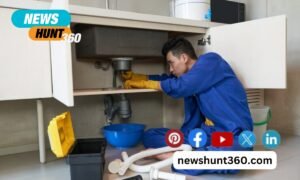Pennsylvania has seen its share of devastation from high-speed winds and storms. In addition to the threat to human life, the aftermath of a storm includes damage to buildings and other constructed structures. The roof is one of the most vulnerable aspects of a house that falls victim to such high-speed winds and is most prone to breaking or developing cracks.
In this article, we share our experience on how to look for different types of storm damage roof repair and what to do if you find a roof leak.
How to inspect storm damage for roof repair?
Ensure safety first
Inspection of your roof involves accessing places where even a slip can cause physical injuries. After a severe storm, certain parts of the roof might become unstable, and it becomes difficult to predict the consequences of standing there without safety equipment or protective gear on. Moreover, even after the storm has passed, it might be windy, and a strong force can displace you or make you lose footing.
Inspect your gutters
Due to high-speed winds, debris such as dried leaves, pebbles, and shingle pieces may get carried up and sent flying in all directions. Chances are, after a storm, your gutters might collect these debris pieces and become clogged. Since water is no longer carried from the gutter’s roof, the water-logging can seep into adjoining walls and enter inside. Moreover, the flying debris may hit the gutter pipes and can cause cracks or dents. Inspect the clamps, holding the gutters in place, for damage.
Inspect from the ground & move up
Thanks to gravity, all the debris, and rubble from the storm can be found on the ground nearby and can explain the severity of the damages. Look for roofing pieces, shingles, tiles, or nails that might have been ripped off. Gradually move from the ground up, inspecting the vinyl sidings, the roof flashing, and finally move towards the actual roof.
Look for active leakages and possible water penetrations.
From uprooted shingles to really low angle rains, water can find its way inside your house after a storm. These leakages are disasters waiting to happen as an unchecked leakage can damage the surrounding areas and turn into an expensive roof replacement project later. For slanted roofs, check for leakages in the attic area with a flashlight. Water stains or discoloration on the ceiling, walls, and floor are another indication of water seepage. Don’t wait for black mold to form to realize that your roof is leaking.
Cracks in your roofs can also destroy your house’s energy efficiency as the air inside can easily escape from the cracks and create a temperature imbalance. Your thermostat needs to work extra hard to correct the imbalance, which would result in a costlier utility bill.
How to repair Storm damage?
Assuming that you have completed the inspection of your roofs, it is time to conduct storm damage roof repairs.
Analyze the damage
Sometimes, the storm damage to your roof is not severe and can be corrected by replacing the missing shingles or nailing down the loose ones. On the other hand, certain damages might be hazardous and require immediate repairs, and it would be unsafe to go inside until a roofing contractor has taken a look. Post-inspection, carefully assess the damages and determine the next steps required. If you have tree branches jutting out from your roof, it is advisable not to go inside.
Leave it to the experts.
Unless you are a roofing contractor or someone with extensive experience in dealing with roof repairs, it is advised to contact a roofing professional to address the storm damage related to your roof. The money you save in DIY repairs is minor compared to the amount you will spend on medical bills from any mishaps or future maintenance resulting from ‘botched’ work.
Generate Detailed Documentation
Storm damages are covered under insurance and can be claimed provided that you have documented every damage. Write detailed notes and photograph everything from different angles (while ensuring safety) with timestamps to support your claim. This documentation is also helpful for a roofing contractor to uncover any underlying issues.
Hire a credible contractor
When it comes to roof repairs, hiring the right contractor is vital as their expertise can help you avoid spending a fortune in getting your roof fixed and speed up the claims process to get the project started. Getting a certified roofing expert also ensures that you don’t have to face substandard workmanship.
Wrapping Up
Storms are devastating but getting your roof repaired after a storm shouldn’t be the same. As mentioned in the article, by systematically inspecting, documenting, and contacting the right roofing company or appropriate contractor, your roof can return to its original glory. Additionally, you can plan and research durable roofing materials that provide protection and durability to suggest when the contractor begins the repairs.




